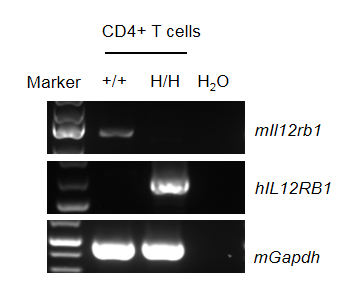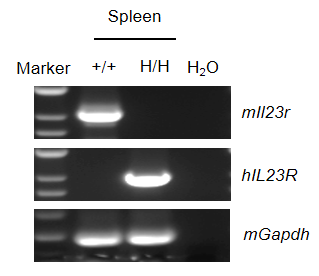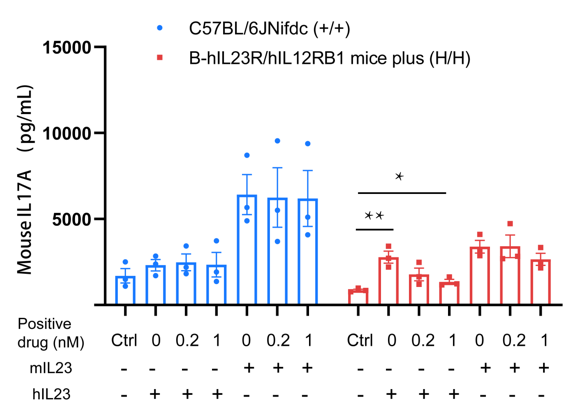B-hIL23R/hIL12RB1 mice plus
| Strain Name |
C57BL/6JNifdc-Il23rtm2(IL23R)Bcgen Il12rb1tm2(IL12RB1)Bcgen/Bcgen |
Common Name | B-hIL23R/hIL12RB1 mice plus |
| Background | C57BL/6JNifdc | Catalog number | 113296 |
|
Aliases |
PSORS7; CD212, IL-12R-BETA1, IL12RB, IMD30 | ||
|
NCBI Gene ID |
149233, 3594 | ||
- IL23 is a member of IL-12-type cytokine family controlling Th17 cells development. Excessive IL-23 signaling has been implicated in the pathogenesis of autoimmune diseases. IL23 is a heterodimer consisting of the unique subunits p19 and p40. IL23 receptor complex consist of two subunits: IL12Rβ1 and IL23R. IL23R is the unique IL23 receptor subunit and IL-12Rβ1 is also the IL12 receptor complex.
- The IL23-IL23R complex signals through JAK kinase and STAT transcription factors, which activates Jak2 and Tyk2 kinases, phosphorylates the receptor, leading to phosphorylation of STAT3, thus activates several pathways including IL17A, IL17F and IL22.
- Gene editing strategy: The extracellular region sequences of mouse Il12rb1 were replaced by human IL12RB1 counterpart gene sequences in B-hIL23R/hIL12RB1 mice plus. Chimeric CDS, composed of human IL23R extracellular region plus mouse Il23r transmembrane and cytoplasmic region, was inserted into the mouse Il23r gene exon 3 in B-hIL23R/hIL12RB1 mice plus.
- mRNA expression analysis: Mouse Il12rb1 mRNA was only detectable in wild-type mice. Human IL12RB1 mRNA was exclusively detectable in B-hIL23R/hIL12RB1 mice plus (H/+, H/H). Mouse Il23r mRNA was detectable in wild-type mice. Human IL23R mRNA was exclusively detectable in homozygous B-hIL23R/hIL12RB1 mice plus (H/H, H/H).
- Functional analysis: Human IL23 can induced mouse IL17A production in wild-type C57BL/6JNifdc mice and homozygous B-hIL23R/hIL12RB1 mice plus. The positive drug can inhibit the expression of mouse IL17A in homozygous B-hIL23R/hIL12RB1 mice plus with hIL23 stimulated.
- Leukocytes cell subpopulation analysis: Humanization of IL23R and IL12RB1 does not change the overall frequency or distribution of immune cell types in spleen, blood, lymph nodes.
- Application: This product is used for pharmacodynamics and safety evaluation of tumors and autoimmune diseases.
- Gene targeting strategy for B-hIL23R/hIL12RB1 mice plus.The extracellular region sequences of mouse Il12rb1 were replaced by human IL12RB1 counterpart gene sequences in B-hIL23R/hIL12RB1 mice plus.
- Chimeric CDS, composed of human IL23R extracellular region plus mouse Il23r transmembrane and cytoplasmic region, was inserted into the mouse Il23r gene exon 3 in B-hIL23R/hIL12RB1 mice plus.
mRNA expression analysis

Strain specific analysis of IL12RB1 mRNA expression in wild-type C57BL/6JNifdc mice and B-hIL23R/hIL12RB1 mice plus by RT-PCR. Spleen separated CD4+ T cells RNA were isolated from wild-type C57BL/6JNifdc mice (+/+) and B-hIL23R/hIL12RB1 mice plus (H/+, H/H), and then cDNA libraries were synthesized by reverse transcription, followed by PCR with mouse or human IL12RB1 primers. Mouse Il12rb1 mRNA was only detectable in wild-type mice. Human IL12RB1 mRNA was exclusively detectable in B-hIL23R/hIL12RB1 mice plus.

Strain specific analysis of IL23R mRNA expression in wild-type C57BL/6JNifdc mice and B-hIL23R/hIL12RB1 mice plus by RT-PCR. Splenocytes RNA were isolated from wild-type C57BL/6JNifdc mice (+/+) and homozygous B-hIL23R/hIL12RB1 mice plus (H/H, H/H), and then cDNA libraries were synthesized by reverse transcription, followed by PCR with mouse or human IL23R primers. Mouse Il23r mRNA was detectable in wild-type mice. Human IL23R mRNA was exclusively detectable in homozygous B-hIL23R/hIL12RB1 mice plus.

Function analysis of IL23R in wild-type C57BL/6JNifdc mice and homozygous B-hIL23R/hIL12RB1 mice plus by ELISA. Splenocytes were collected from wild-type C57BL/6JNifdc (+/+) mice and homozygous B-hIL23R/hIL12RB1 mice plus (H/H), then CD4+ T cells were isolated and cultured on anti-mCD3ε antibody and anti-mCD28 antibody pre-coated plates, and stimulated with indicated concentrations of mouse IL23 recombinant protein (10 ng/mL) or human IL23 recombinant protein (10 ng/mL), and different concentrations of positive drug (0 nM, 0.2 nM, 1 nM) at 37℃ for 48 h. Cell supernatants were collected for ELISA analysis of mouse IL17A (BioLegend, 432504). Mouse IL23 can induced mouse IL17A production in wild-type C57BL/6JNifdc mice and homozygous B-hIL23R/hIL12RB1 mice plus. Human IL23 can induced mouse IL17A production in wild-type C57BL/6JNifdc mice and homozygous B-hIL23R/hIL12RB1 mice plus. The positive drug can inhibit the expression of mouse IL17A in homozygous B-hIL23R/hIL12RB1 mice plus with hIL23 stimulated. The positive drug is provided by the client.

Frequency of leukocyte subpopulations in spleen by flow cytometry. Splenocytes were isolated from wild-type C57BL/6JNifdc mice (male, n=3, 6-week-old) and homozygous B-hIL23R/hIL12RB1 mice plus (male, n=3, 6-week-old). A. Flow cytometry analysis of the splenocytes was performed to assess the frequency of leukocyte subpopulations. B. Frequency of T cell subpopulations. Frequencies of T cells, B cells, NK cells, DCs, granulocytes, monocytes, macrophages, CD4+ T cells, CD8+ T cells and Tregs in B-hIL23R/hIL12RB1 mice plus were similar to those in C57BL/6JNifdc mice, demonstrating that humanization of IL23R and IL12RB1 does not change the frequency or distribution of these cell types in spleen. Values are expressed as mean ± SEM. Significance was determined by two-way ANOVA test. *P < 0.05, **P < 0.01, ***p < 0.001.












 京公网安备:
京公网安备: